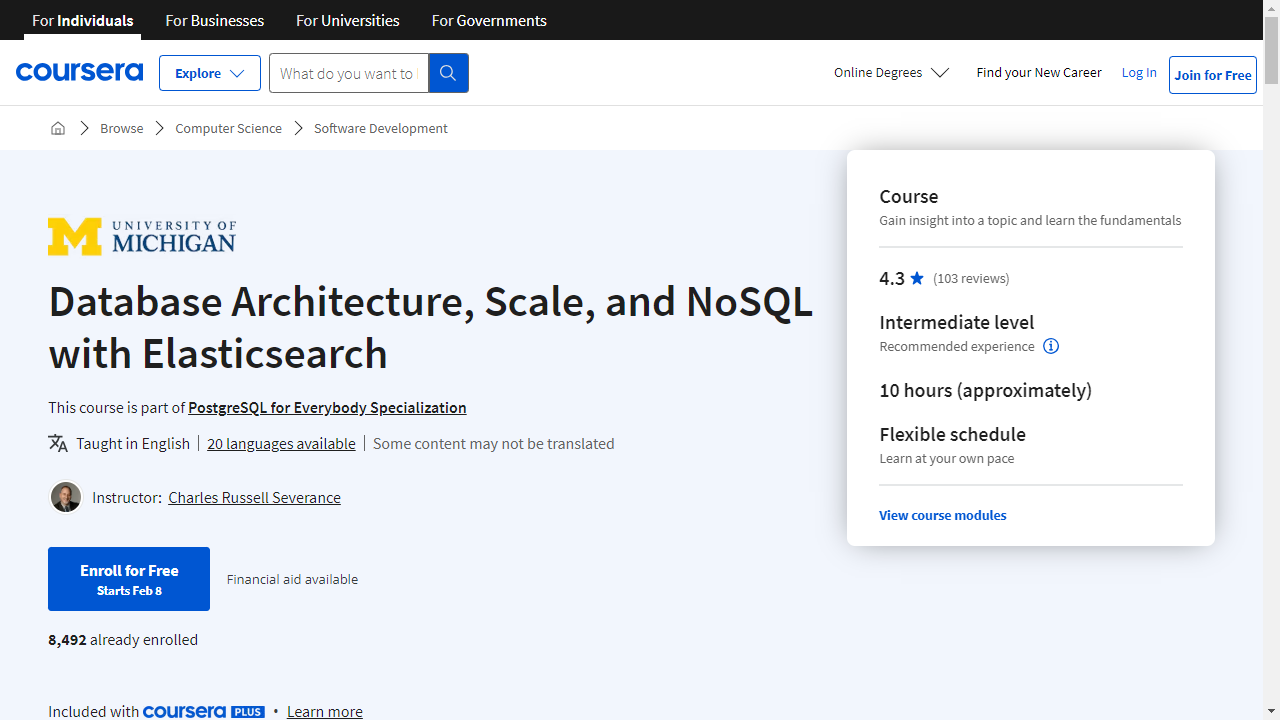Elasticsearch is a powerful open-source search and analytics engine built on Apache Lucene.
It allows you to store, search, and analyze massive amounts of data quickly and efficiently.
Elasticsearch is widely used for applications like log analytics, full-text search, business intelligence, and more.
By learning Elasticsearch, you can unlock the ability to build scalable and high-performance applications that can handle large datasets and complex search queries.
You’ll be equipped to work with the Elastic Stack, which includes Logstash for data ingestion and Kibana for data visualization, making you a valuable asset in today’s data-driven world.
Finding the right Elasticsearch course can be overwhelming, with numerous options available online.
You want a course that provides a comprehensive understanding of Elasticsearch’s features, covers practical applications, and offers hands-on experience.
You’re looking for a course that fits your learning style and helps you master Elasticsearch to advance your career or build powerful search applications.
Based on our research and analysis, Complete Guide to Elasticsearch on Udemy stands out as the best Elasticsearch course overall.
This course offers a deep dive into Elasticsearch, covering everything from basic concepts to advanced topics like sharding, replication, and aggregations.
It provides a strong foundation in Elasticsearch and equips you with the skills needed to build and manage Elasticsearch clusters effectively.
However, depending on your specific needs and learning preferences, other Elasticsearch courses might be a better fit.
We’ve compiled a list of the best Elasticsearch courses available, catering to different levels of expertise and learning goals.
So, continue reading to discover the perfect Elasticsearch course to embark on your learning journey.
Complete Guide to Elasticsearch
Provider: Udemy
This Udemy Elasticsearch course guides you through the intricacies of Elasticsearch, a powerful tool for storing and searching data.
You start by understanding Elasticsearch and its ecosystem, including the ELK Stack (Elasticsearch, Logstash, Kibana) and other components like Beats and X-Pack.
The course covers installation and setup on different operating systems (macOS, Linux, Windows) and how to run Elasticsearch in Elastic Cloud.
You then explore core concepts like nodes, indices, and documents, and learn how to manage documents using CRUD operations (create, read, update, delete).
You will master sharding and replication for scalability and high availability, and dive into topics like document versioning and optimistic concurrency control, crucial for data integrity.
Next, you delve into mapping and analysis, exploring how Elasticsearch indexes and stores data using various data types like “keyword,” “nested,” and “object.”
You learn about text analysis, including stemming, stop words, and how to create custom analyzers.
You’ll discover how to handle synonyms, improve search results by accounting for typos, and control relevance scores.
The course further explores different search techniques using term-level queries, full-text queries, and compound queries, allowing you to retrieve data efficiently.
You learn about joining queries, which enable you to model relationships between documents and perform searches based on those relationships.
Finally, you discover the power of aggregations, extracting insightful statistics from your data through various aggregation methods.
Database Architecture, Scale, and NoSQL with Elasticsearch
Provider: Coursera
This course takes you from the basics of SQL databases to the modern world of NoSQL, showing you how to use Elasticsearch.
You will start by learning why scaling traditional relational databases can be difficult and discover concepts like ACID properties.
This foundation helps you understand the rise of NoSQL solutions like Elasticsearch.
You will then explore BASE solutions, comparing them to ACID properties.
The course focuses on Elasticsearch, teaching you the fundamentals, programming methods, and practical applications.
You will learn by doing, loading data like books, emails, and tweets into Elasticsearch.
This hands-on experience shows you how to use Elasticsearch for searching, indexing, and analyzing real-world data.
You will also peek into how tech giants like Google, Amazon, and Microsoft use platforms like Google Cloud Platform, AWS, and Microsoft Azure to handle massive datasets.
These platforms often rely on technologies like Elasticsearch to manage complex queries.
This course teaches you how to program Elasticsearch, a crucial skill for building modern applications that demand efficient search functions.
You will gain practical experience loading data into Elasticsearch, preparing you to build robust and scalable databases using NoSQL solutions and Elasticsearch.
You will learn by working on mini-papers and watching demonstrations, like Marissa Mayer’s Google I/O 2008 presentation, to understand how Elasticsearch works in the real world.
Complete Elasticsearch Masterclass with Logstash and Kibana
Provider: Udemy
You will start with the fundamentals of Elasticsearch, learning how it manages data, and then progress to performing basic operations like indexing, retrieving, and deleting documents.
The course then delves into analyzers, crucial for text analysis in indexing and searching.
You will discover how to define your index structure using mappings and field types to build a solid and organized data structure.
You will gain a comprehensive understanding of the Elasticsearch Query DSL, learning to use its query and filter components to extract meaningful insights.
The course then introduces aggregations, a powerful tool allowing you to group data and perform calculations for insightful analysis.
Finally, you will apply your knowledge to a real-world project using Logstash, Filebeat, and Kibana.
You’ll configure Logstash to ingest data from sources like Apache logs and CSV files.
Using Kibana, you will then create visualizations and dashboards to present your data effectively.
This practical experience will give you a deep understanding of architecting the Elastic Stack to ensure efficient data processing and analysis.
With dedicated TA support and a Discord community to assist you, you’ll emerge from this course with a solid understanding of the Elastic Stack and the ability to build powerful search and analytics applications.
Elasticsearch 8 and the Elastic Stack: In Depth and Hands On
Provider: Udemy
This course takes you on a journey from installing Elasticsearch on your computer, using a virtual Ubuntu machine, to understanding the architecture of the Elastic Stack, including components like Logstash and Kibana.
You’ll learn how to communicate with Elasticsearch using its RESTful API, which relies on standard HTTP requests.
The course uses the MovieLens dataset to teach you how to work with data in Elasticsearch.
You’ll cover everything from basic data manipulation (inserting, updating, deleting documents) to handling more complex scenarios like concurrency issues.
You’ll explore Elasticsearch’s powerful search capabilities, including full-text, fuzzy, and partial matching.
The course will also guide you through importing data from various sources like JSON, MySQL, and Amazon S3, using tools like Logstash.
You’ll gain a deep understanding of Elasticsearch aggregations, learning how to extract valuable insights from your data using techniques like histograms, time series, and nested aggregations.
The course introduces you to Kibana, the visualization tool for Elasticsearch.
You’ll discover how to use Kibana to explore your data visually, create insightful dashboards, and even leverage Elasticsearch’s SQL capabilities for querying.
Finally, the course takes you beyond the basics, covering Elasticsearch operations.
You’ll learn to configure, monitor, and scale your Elasticsearch cluster for optimal performance.
The course provides practical advice on choosing the right hardware for your needs, troubleshooting common issues, and using snapshots for data protection.
You’ll also explore cloud-based Elasticsearch options like Amazon Opensearch Service and Elastic Cloud.
ElasticSearch, LogStash, Kibana ELK #1 - Learn ElasticSearch
Provider: Udemy
This course on Udemy thoroughly explains ElasticSearch, the powerful search engine perfect for handling large amounts of data.
You will develop a strong understanding of its core ideas, starting with the basics and advancing to more complex features like ensuring high availability and scalability for your data.
You’ll gain practical experience by setting up ElasticSearch on AWS EC2 instances, learning how to use its APIs for adding, retrieving, and searching data.
The course explains the differences between ElasticSearch and traditional systems like RDBMS and demonstrates why ElasticSearch might be the better option for your needs.
You’ll get to practice with sample datasets, compose search queries, and learn how to define custom mappings for various data types.
The course then introduces the ELK stack – a combination of ElasticSearch, LogStash, and Kibana.
You will discover how this powerful stack is used to analyze massive datasets (Big Data) and its significance in real-world scenarios.
Also check our posts on:





